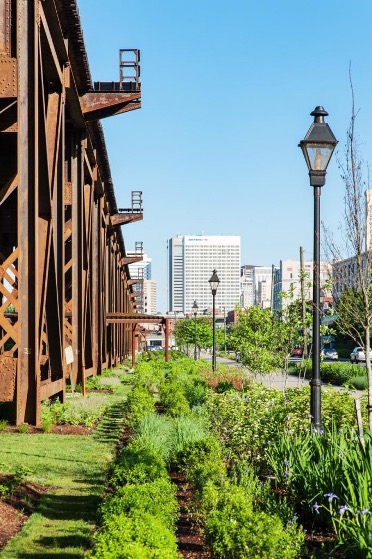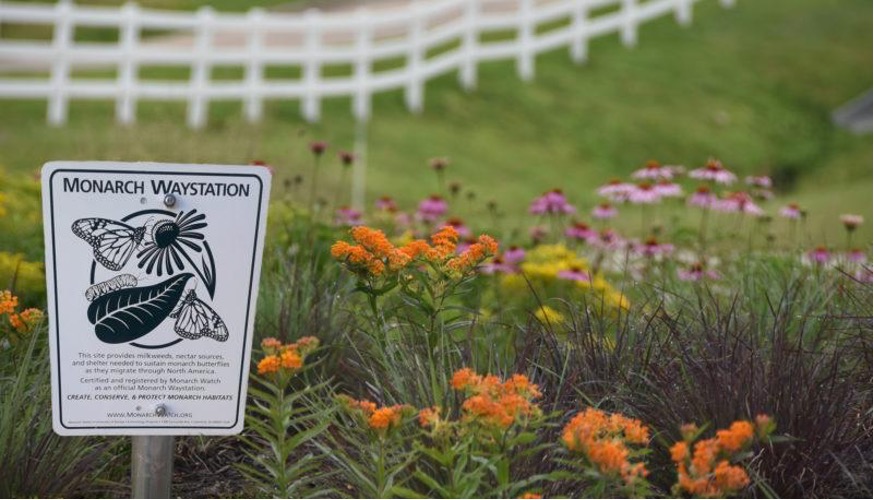Written by: Anna Aquino
How many monarch butterflies did you see last summer? When you turn on your porch light do moths flutter to and fro? Is night time illuminated with yellow lightning bug squiggles to the delight of children, and the child in all of us? When was the last time a bug splattered on your windshield (this one has a name it’s called the “windshield phenomenon”).(1) If you’re of a certain age you will have noticed these missing little creatures, if you’re of the younger variety you probably think things have always been this way. We used to have bugs. Bugs were everywhere. What happened to all the bugs?
Eco-services of Insects
Insects are the most ubiquitous terrestrial animals. They are the food for countless species of birds. Insects drive the distribution and abundance of plants and animals. Most flowering plants depend on insects for pollination, reproduction, and survival. Insects consume waste, and are essential to the recycling of nutrients. Without dung beetles, a cow pasture would be all cow patty. The eco-services insects provide to our US agricultural economy hits 70 billion dollars annually, so if it’s not biodiversity we want to protect but our lunch, we better do something.(2)
A pair of chickadees must find 6000 to 9000 caterpillars to rear one clutch of young.(3) Our birds are in crisis and it is largely attributed to the loss of wildlife habitats, add to that we have inadvertently displaced native plants with invasive plants that are often of little to no food, reproductive, or life cycle value. The dire situation is revealed by the results of a study by the Cornell Lab of Ornithology, revealing in the U.S. and Canada nearly 30% of birds have been lost in the last 50 years.(4) Bats are responsible for providing more than $3.7 billion in pest control every year, especially mosquitoes and pests of agricultural crops, but they depend on our overall insect populations for species survival.(5) So here is the tally on our declining pollinators as published in Audubon: “About 16.5 percent of bird and mammal pollinators (that includes bats, marsupials, monkeys, lemurs and rodents) are currently threatened with extinction, while more than 40 percent of pollinating insects—especially bees and butterflies—are similarly threatened, according to the task force of about 80 experts.”(6)
Scientists say a constellation of factors has caused the decline in insects, called an “insect apocalypse” by Michael McCarthy, “A giant insect ecosystem is collapsing due to humans. It’s a catastrophe.”(7) This sharp decline in numbers and diversity will jeopardize insect eco-services, cascading through the food web, resulting in an “ecological Armageddon”.(8) Habitat degradation and loss, pesticide use and pollution, the loss of native plants, monoculture agriculture, invasive species rolling roughshod, light pollution, and as always climate change are all indicted. Pollinator decline is especially scary because of the essential role they play in animal and human existence, a group of insects that has special value to a thriving and well fed world. Pollinators participate in some form or fashion with 75% of plant species to bring their seed or fruit to fruition. Without pollinators 1/3 of the food we eat would be gone.(9)
The author of this article had the distinct honor of speaking to Dr. Doug Tallamy of University of Delaware and Sharon Selvaggio of the Xerces Society for Invertebrate Conservation about pesticides and insects. Ms. Selvaggio, a pesticide specialist and educator, gave information that, along with Dr. Tallamy’s, will be provided in an upcoming blog on pesticide use. Most stirringly she said “what is the cost of that perfect boxwood, and how much does the quest for that perfect boxwood hurt the ecosystem.” Look to control measures that do not employ synthetic pesticides, she added that organic pesticides can also be highly toxic, but an advantage is most degrade quickly from the environment. Both she and Dr. Tallamy tell us that a messy garden is a healthy garden and an imperfect plant means we are doing something right.

Becoming a Bee City
Capital Trees, aware that “the little things that run the world” (E.O. Wilson) are in crisis, and is sponsoring the effort to have Richmond commit to life-saving measures that becoming a Bee City would provide, and Anna Aquino, a member of our Board of Trustees, is co-chair of Bee City.(10) These promises to conserve and advance native pollinators will equally help all insect populations, and “create a greener, more livable Richmond.” Richmond, as have other Bee Cities, Bee Counties, and Bee Campuses will advocate for pollinators in a number of ways. Affiliates are committed to protecting existing natural habitats, to building new pollinator habitats, to emphasizing native plantings in design, and to using fewer pesticides and pollutants. If Richmond City Council approves the Bee City USA Richmond Resolution, brought to it by Capital Trees, our Bee City Working Committee, by the four garden clubs of the Garden Club of Virginia, and by our city liaison, the Department of Recreation and Community Facilities, Richmond, will in various and fun ways, promote, educate, and celebrate, pollinators and insects. All are welcome to join the Bee City Working Committee and bee part of how Richmond distinguishes itself as a Bee City.
In 2020 Capital Trees discontinued use of backpack spraying of herbicide, choosing to pull a weed over pulling a trigger releasing a toxic herbicide, no synthetic chemicals at all, no little cardboard signs that warn to “stay out for a while” until the chemical spray dries, residue only to be reactivated by the morning dew. And where are the best looking public gardens in Richmond? We are a little biased but our Low Line Gardens along Dock Street are pretty glorious, and without a dot of synthetic chemicals. They are managed sustainably in an array of ways to protect insects and to be kind to the environment, and at a lower cost than when we used commercial landscape contractors. Pretty good advertisement for Sustainable and Organic Gardening Practices.(11)

Ways You Can Help
From the Proceedings of the National Academy of Sciences, learn of “Eight Simple Actions that Individuals Can Take to Save Insects from Global Declines.” For instance, convert lawns to natural habitats of native plants. Reduce pesticide use. (12—see excellent article for all) On the topic of letting nearly useless mowed monoculture lawn find its unrealized potential, please see Doug Tallamy’s Homegrown National Park Grassroots Call-To-Action, join the movement!(13) Try to plant true species and avoid cultivars. Be sure to notice whether the cultivar you are considering has offerings for pollinators. There is a worsening terrible trend in horticulture cultivation where sterile plants are marketed for some visual attribute, and pollen and nectar have been eliminated (many hydrangea). Dr. Tallamy looked at various cultivar attributes regarding leaf-eating, which can be necessary through all stages of an insect’s life; he found that the most problematic alterations are changing leaf color, most notably green leaves to red/purple. The anthocyanins are unpalatable, sometimes toxic, strongly deterring eating.(14)(15)
Neonicotinoids (that Bayer Tree & Shrub in the garage) are the most widely used insecticides on the planet and are acutely toxic to bees/most insects.(16) No wonder we have such a sharp decline in our pollinators. Be more tolerant of cosmetic damage on plants, and when you see insect or fungal damage on a plant, let the last action you consider be using a synthetic pesticide. Increased tolerance of, mechanical removal (pruning and scrubbing), biological controls (buy lacewings and ladybugs on Amazon), organic products (neem oil or dormant oil can be considered, applying properly (upcoming blog on pesticides)), and synthetic pesticides as the absolute last resort, if at all.
“IPM is an ecosystem-based strategy that focuses on long-term prevention of pests or their damage through a combination of techniques such as biological control, habitat manipulation, modification of cultural practices, and use of resistant varieties.”(17)
Mow less often, allowing plants to flower for pollinators. Only use lawn companies that offer “certified organic,” and kick mosquito spraying companies to the curb because they are a major reason for insect decline. Leave “wildlife trees,” these are dead or dying trees, stumps, and logs,— they sustain innumerable organisms, bacteria and fungi, native bees, beetles, and reptiles and are nature’s sculptures. Turn the wildlife tree into a centerpiece, a purposeful part of the habitat garden. “There is often more life in a dead tree than in a living tree,” the Snag Lady of California declares, and “When we haul away a dead tree needlessly, we take away half its life’s destiny.”(18) Join the Xerces Society for Invertebrate Conservation, the nonprofit that is sponsoring the Bee City USA Initiative, and proudly display your Monarch Waystation or Pollinator Habitat sign, available from Xerces.


- https://www.science.org/content/article/where-have-all-insects-gone
- https://www.nap.edu/read/989/chapter/4
- https://www.smithsonianmag.com/science-nature/meet-ecologist-who-wants-unleash-wild-backyard-180974372/
- https://news.cornell.edu/stories/2019/09/nearly-30-birds-us-canada-have-vanished-1970
- https://www.usgs.gov/faqs/why-are-bats-important
- https://www.audubon.org/news/what-do-birds-and-bees-have-do-global-food-supply
- https://www.theguardian.com/environment/2017/oct/21/insects-giant-ecosystem-collapsing-human-activity-catastrophe
- https://www.theguardian.com/environment/2017/oct/18/warning-of-ecological-armageddon-after-dramatic-plunge-in-insect-numbers
- https://www.pollinator.org/pollinators
- https://beecityusa.org/
- “CAPITAL TREES—SUSTAINABLE AND ORGANIC PRACTICES FOR OUR PUBLIC LANDSCAPES” by Anna Aquino, Projects Committee Chair, Board of Trustees Capital Trees Nonprofit
- https://www.pnas.org/doi/10.1073/pnas.2002547117
- https://homegrownnationalpark.org/
- https://www.ecobeneficial.com/2015/10/the-nativar-conundrum-new-research-on-natives-vs-native-cultivars-with-dr-doug-tallamy/
- https://piedmontmastergardeners.org/article/native-species-or-cultivars-of-native-plants-does-it-matter/
- https://xerces.org/publications/scientific-reports/how-neonicotinoids-can-kill-bees
- https://www.nifa.usda.gov/about-nifa/impacts/science-big-battle-against-small-enemies
- https://cavityconservation.com/


This article is GREAT with wonderful resources for follow-up information. Thank you so much